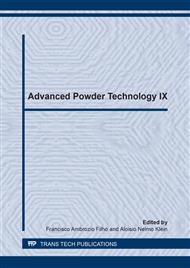p.285
p.291
p.297
p.303
p.311
p.317
p.323
p.329
p.334
Fe-hBN Composites Produced by Double Pressing and Double Sintering
Abstract:
In order to develop a composite for future applications as self-lubricating material, samples with iron matrix and contents of hexagonal boron nitride (hBN) of 0, 2.5, 5, 7.5 and 10 vol%. were produced by conventional powder metallurgy, varying the compacting pressures. It was observed a decrease of mixture flowability and apparent density when increasing hBN content. Moreover, the samples showed an increment of green densification with the increase of applied pressures and hBN contents, suggesting that hBN particles accommodate into the voids during pressing. As known, hBN has low shear strength and is insoluble in the iron matrix, which hinder the formation of necks between the particles of iron during sintering. To improve matrix continuity the double pressing technique was used, and this technique presented increments of 3 to 5% of densification and up to 95% of tensile strength when compared with the composites produced by single pressing.
Info:
Periodical:
Pages:
311-316
Citation:
Online since:
December 2014
Price:
Сopyright:
© 2014 Trans Tech Publications Ltd. All Rights Reserved
Share:
Citation:


